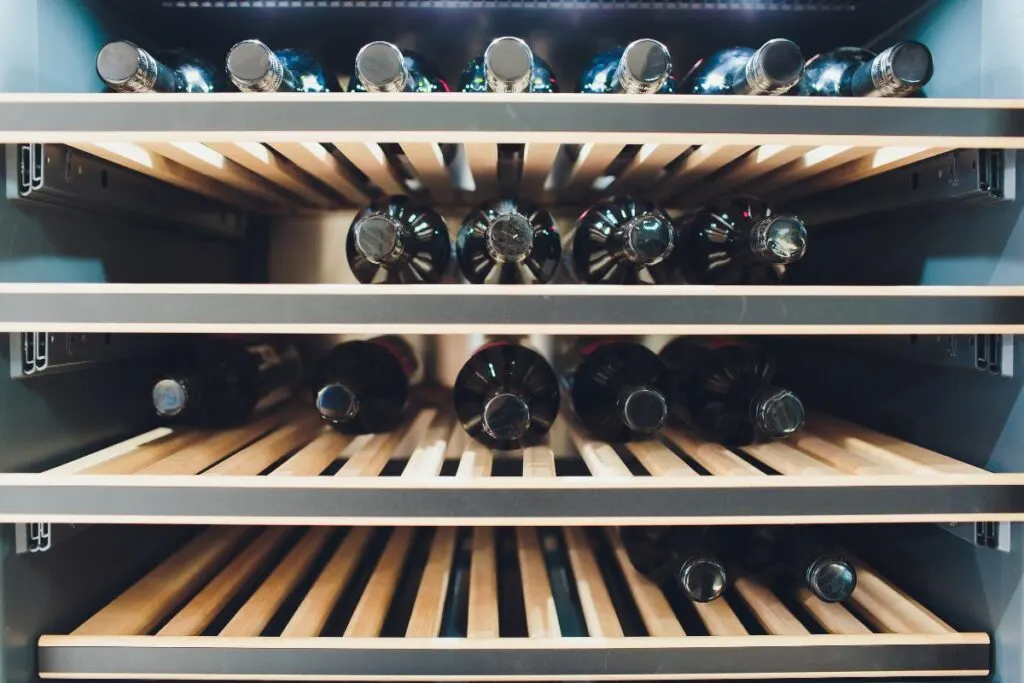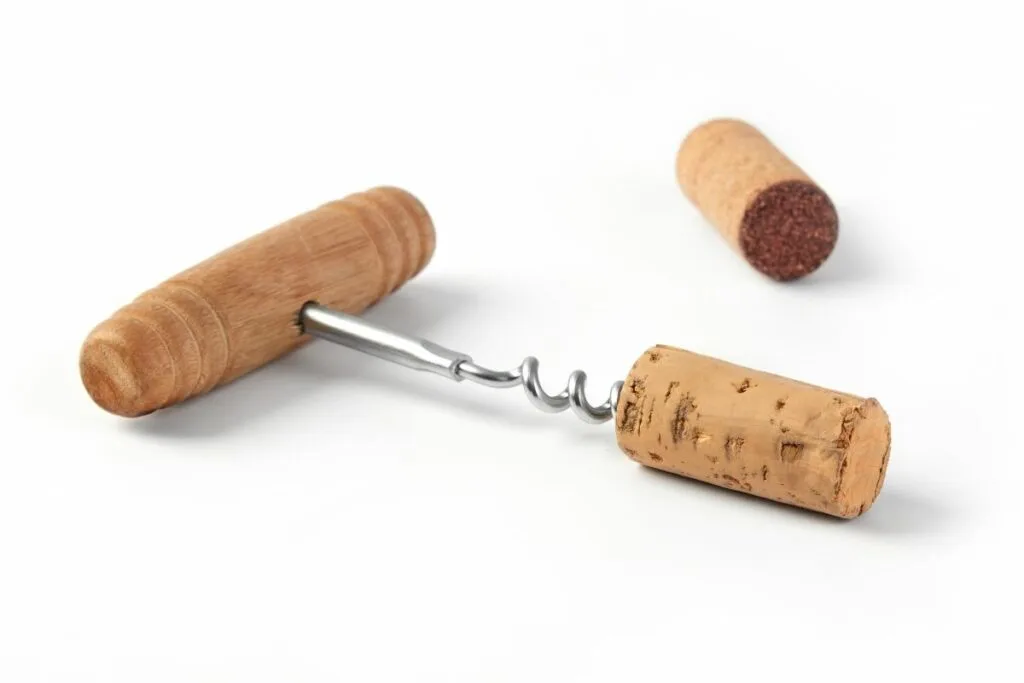As an Amazon Associate, I earn from qualifying purchases with no additional costs for you.
Moscato is one of the most popular wines on earth. It is only growing in popularity as more and more wine drinkers are meeting it for the first time. But so many people are unsure of how to store Moscato — both unopened and once the cork is popped. How should you store Moscato to keep it fresh and tasting great longer?
Unopened Moscato is best stored around 55° F in a dark, temperature-stable environment laying flat on their side with labels facing up.
Opened Moscato will last for up to 1 week after the cork is popped if you store it in a refrigerator standing upright with a quality wine preserver like Vacu-Vin to retain the freshness.
In this article, we will cover everything you need to know about storing, decanting, and aerating Moscato. You really should know how to properly store this beautiful wine. If you find this article helpful, please share it on social media with people you care about.

TIP: If you want to check out the best refrigerator for wine storage, I recommend trying out the Avation (18 bottles) compressor refrigerator with Wi-fi smart app control cooling system. You can find this refrigerator by clicking here (Amazon link).
What is Moscato?
Moscato is a sweet, fizzy white or rose wine with a low alcohol content that’s delightfully sweet and affordable. Moscato is made from the Muscat grape which is a table grape also used for raisins. Flavors of Moscato are usually sweet peach, orange blossom, and nectarine.
Recommendation box: Everything you need to enjoy your wine as much as possible. All recommended products are personally tested and regularly used by experts from this website (Amazon links):
> Ivation Wine Cooler – Energy-efficient wine cooler for 18 bottles with Wi-fi smart app control cooling system.
> Wine Rack – Beautiful, elegant wood rack for up to 7 bottles and the choice of vertical or horizontal storage.
> Durand Wine Opener – Classic vintage wine opener (we like all these classic staff).
> YouYah Iceberg Wine Decanter – The most beautiful and handy wine decanter we personally use.
> Bormioli Rocco Wine Glasses – A set of eight elegant and traditional wine glasses made in Italy.
> Vintorio Wine Aerator – Simple but really useful wine aerator for a reasonable price.
> The Original Vacu Vin Wine Saver – The best wine saver on the market in a package with two vacuum stoppers and two wine servers.
And if you want to become a true connoisseur of wine, we recommend reading the book Wine Folly: The Essential Guide to Wine (Amazon link), where you will find all the information you need about winemaking, wine varieties, flavors, and much more.
The Popularity of Moscato
In 2012, Moscato passed Sauvignon Blanc as the third most-sold wine in the United States. The wine’s popularity has also soared recently since many popular music artists mention it in their songs!
Moscato has replaced some of the fancier traditional varietals for some wine lovers. It is fun to drink, and for the most part, often affordable.
Once thought of as only a dessert wine, Moscato’s refreshing flavor profile and low alcohol content (5-7% alcohol by volume) make it a favorite porch/patio wine for many.
Moscato and Food
Moscato’s flavors are sweet with hints of orange blossom, peach, and other fruit flavors. Because of the wine’s sweetness, Moscato is perfect with creamy desserts and fruit tarts.
Caramel, butterscotch, vanilla, and coconut all match wonderfully with Moscato, but don’t pair it with chocolate – the two flavors will present too much richness when put together.
Spicy, aromatic Chinese food pairs well with Moscato. When paired with Chinese dishes that predominately have ginger, Chile pepper, and cardamom, Moscato’s flavors will really shine.
Wines Similar to Moscato
There aren’t too many wines similar to Moscato because of its low alcohol content and the fizzy, aromatic nature of the wine. However, for reference, Gewurztraminer, semi-sweet versions of Prosecco, and sparking versions of semi-sweet Rieslings are similar.
Making Moscato
Making Moscato entails bottling it with a bit of carbon dioxide to produce bubbles. This is how Moscato gets its fizzy texture. The carbon dioxide also helps to ensure that not all of the sugar converts to alcohol, giving it some of its sweet flavors.
How to Store Unopened Moscato

The way you store your wine can make or break your chances of properly sustaining it. When preserved correctly, your Moscato can last until you’re ready to open, drink, and enjoy it!
Below find simple steps for storing your unopened Moscato.
- Store at the proper temperature. Temperature is by far the number one factor influencing the quality of stored wine. Temperatures that are too warm or too cold are the most common downfalls of any wine. In general terms, the ideal temperature for long-term wine storage is around 55 degrees F, but this can vary from wine to wine. Moscato’s low alcohol content will make it more susceptible to temperature and it will need to be stored around this ideal temperature.
For temperature recommendations about your specific Moscato, you can always consult the manufacturer. No matter what type of wine or who the producer is, your wine should never be kept below 25 degrees F.
TIP: Which wine can be stored at room temperature? This article explains. How do you safely store wine without a wine refrigerator? Find out here.
This temperature could actually cause the wine to freeze. If stored above 68 degrees F the aging process will be accelerated and important compounds in the wine will be destroyed.
The most important factor concerning temperature is actually fluctuation. A Moscato wine temperature should be kept as stable as possible.
Fluctuations in wine temperature can cause the cork to expand and contract, allowing the wine to seep out – or air to seep in – around it.
- Store bottles with corks horizontally. Be careful to store your Moscato – with cork fastenings – horizontally. Keeping the wine on its side helps keep the cork moist, which is very important for wine storage. A dried-out cork will cause premature aging. If your Moscato has a screw cap it’s not necessary to store the bottle on its side.
A riddling rack keeps the wine in the correct horizontal position and can also be a conversation/decorative piece to have in your home.
The riddling rack was invented in the early 1800s by the Veuve Clicquot Champagne House as a way to hold bottles of wine in the process of making sparkling wine.
The process of riddling was a way to rotate the bottles from horizontal to vertical over a period of days. On a daily basis, a riddler would rotate every bottle a few degrees which is an art in itself!
This worked the sediment to the neck of the bottle making it easier to remove that sediment when the time came. This process is called disengagement.
TIP: Having quality storage racks for your wine is not only practical but can also serve as a nice design accessory for your home. We loved these (Amazon links):
- Ferfil Wine Rack (10 Bottles): Concertina/scissor fold wooden wine rack made of solid, eco-friendly wood.
- Gusto Nostro Wood Wine Rack: Beautiful, elegant design, the possibility of storing up to 7 bottles, and the choice of vertical or horizontal storage.
The racks are great looking and there are free-standing versions as well as ones that can be mounted to a wall. They can be quite a statement piece!
- Protect the wine from light and vibration. Even if you’re only storing your Moscato for a matter of days, try to keep your wine in the dark as much as possible. Many people have heard this when storing wine for weeks or months, but Moscato can be particularly susceptible to UV rays from direct sunlight. You should also keep your wine away from potential sources of vibration such as a washer and dryer or exercise equipment in an exercise room. Vibrations disturb sediments in the bottle that are meant to cause wines to age favorably.
- Store your Moscato at the proper humidity. Humidity extremes in your storage area can affect your wine’s potential long life. Lower humidity levels cause the cork to dry out leaving the wine to deal with negative oxygen levels. High humidity can destroy your labels. The humidity in your storage area should be between 60 and 68 percent. A dehumidifier can also help.
- If possible, store your wine in a wine fridge not a regular kitchen fridge. A wine refrigerator or a wine cooler is a good idea if you don’t have a wine storage space that’s consistently cool, dark and moist. A standard refrigerator is meant to keep food very cold and dry. A wine fridge keeps wine between 50 and 60 degrees F and a good one will have a humidity setting.
If cost is a factor, remember that wine can be an investment. Monthly spending on wine can justify the cost of a wine fridge or cooler. In some scenarios, it will be a good way to protect your investment.
If you’re wondering whether or not to invest in a wine cooler, ask yourself these questions.
- Do I want to sign up for a wine-of-the-month club?
- Would I like to visit vineyards and be able to bring back my favorites for later enjoyment?
- Do I want to be able to take advantage of store sales by buying in bulk?
- Would I like to catalog, coordinate, and organize my wine while still keeping it available to consume whenever I want?
Your wine collection is an investment in your social gatherings and in yourself. Besides providing relief to your refrigerator, each bottle will be provided with the correct temperature should you opt for a wine fridge.
Is Moscato a Wine that Would Benefit from Aging?

Moscato is generally considered a wine to be consumed upon release, however, the bright acidity in some Moscato has great aging potential when stored in the right conditions (mentioned above).
For example, Moscato di Asti, one of the most popular Moscatos on the market, is fragrant, foamy, fresh, and delicious. While there aren’t many examples of aged Moscato di Asti out there, it’s worth putting back a bottle to see what this wine may have in store when put away properly!
Below is an example of what you may expect from aging a Moscato di Asti for a period of ten years.
(Moscato di Asti when first released is typically a silky, low alcohol sparkling wine made entirely from Muscat grapes and its sensations include orange blossom, apricot, thyme, and lemon).
Starting off with its first year it would exhibit a textbook flavor profile of wildflower, chopped herb, and ripe apricot.
Year two it would still be fresh and fragrant with Mediterranean herb sensations and a creamy lemon drop finish.
Year three would bring floral and eucalyptus aromas with a hint of graphite.
Year four yields a deeper color, dried apricot, pinesap, and aromatic herb sensations.
Year five boasts intense thyme, orange zest, lemon drop, and cedar sensations. While the wine is still fresh, it’s now gaining depth.
Year six sees increasing polish while still being fresh and becoming more polished. Lime, yellow peach, and wild herb sensations are now in the mix. The wine closes on a graphite note.
Year seven brings complexity and finesse. Rosemary, crushed mint, and kerosene sensations make the wine more remarkable now. Tangy orange and a nutty finish now define the wine.
Year eight – the wine is yet even deeper in color, but still very fresh. The depths of flavor now include hazelnut and white grapefruit with a mineral juicy acidity. The depth of these flavors is stunning.
Year nine – No longer sparkling, this is now more of sweet wine to linger over. It offers candied lemon drop, honeyed almond, and dried apricot flavors. Polished and smooth, the palate is almost savory with lemon pastry cream sensations.
Year ten – The wine is now very deeply colored and no longer hints that it was ever sparkling. The fresh acidity brightens the candied lemon, ripe apricot, and balsamic herb. Honey notes linger on the finish.
Storing Moscato after Opening

Stored properly, an opened bottle of wine can last 3-5 days. The key to extending the shelf life of an open wine is to re-cork it promptly and tightly.
Re-Cork Properly
To re-cork, your bottle of Moscato, place some wax paper around the cork and slide it back into its original position. The wax will ease the cork into the top and also ensure that no part of the cork will drop into the bottle.
Resist the urge to fit the “clean’ side of the cork back down into the bottle. While it may be easier to fit into the bottle, the stained side has already been exposed to the wine, ad it tasted fine. That “clean” side may not be so clean, and it can taint what you’re trying to save.
Tips for Keeping Moscato Longer than the Normal 3-5 Days
Use Half Bottles
To minimize air exposure – the enemy of your wine – use a funnel to pour the remaining wine into a screw-cap half-bottle. If there’s still some air at the top, it’s a lot less than a regular bottle. Air can flatten the wine lessening flavors and aromas.
Refrigerate it
It’s a known fact that wine sits out on the counter after drinking it and re-corking it much more often than it should. People don’t think there are consequences to this since it’s not “food”. The cooler temperature of the refrigerator slows the process of the wine breaking down so the sooner you get it in the fridge, the better.
TIP: Are you interested in buying a wine stopper? We’ve personally tried and recommend buying one of these wine stoppers (Amazon links):
- The Original Vacu Vin Wine Saver: Our top choice. Very easy-to-use wine stopper/saver. You can enjoy a glass of fresh wine whenever you want without worrying about wasting any.
- EZBASICS Wine Saver: Great alternative to Original Vacu Vin Saver. This wine stopper keeps the flavor of wine for up to one week.
- Champagne Stopper by MiTBA: Wine stoppers for sparkling wines are different. This wine stopper seals your bottle and increases the pressure so your beverage’s bubbles won’t go to waste.
Use a Wine Vacuum Pump
If re-corking isn’t an option – if the cork broke while opening or has been thrown away – a rubber cork stopper can create a tight seal. Another popular option for re-corking wine is a wine vacuum pump. The pump enables you to suck the air out of an open bottle, creating an almost airtight seal.
Get a Wine Preservation System
A Coravin is a device that pierces the cork with a needle and tops the bottle off with argon gas. You will pour what you want, remove the needle, and the cork will seal back naturally. Many restaurants use it to sell high-end bottles by the glass.
TIP: Most wines go bad once you pop the cork within a day or so. But a Coravin Wine Preservation system (available for a great price on Amazon) can extend the life of your opened wine for weeks or even months. It is awesome. You should check it out to see if it fits your lifestyle.
You can always finish it!
With all this being said, you can always not worry about how to save the wine and just drink it! There are about 5 glasses of wine in a regular 750-ml bottle.
TIP: Do wine bottles break easily? Our wine expert weighs in on this article. Do you know why a wine bottle is 750ml in the USA and 700ml in Europe? Find out the interesting answer here.
If you and a guest have 2 glasses each with dinner, that’s great! According to some medical professionals – 1-3 glasses may improve your health.
How to know if Your Moscato Has Gone Bad
If you get ready to drink your bottle of Moscato and the wine is a brownish color or muddy looking then heat or oxidation is probably to blame. Oxidation simply means that air has gotten to the wine. (A white wine that has oxidized will look amber-colored instead of bright).
Tart, cabbage-like aromas, or a barnyard smell is also something to look out for. A sulfur smell, wet dog, and/or a musty basement odor are some of the more undesirable smells that are going to make your wine unpleasant to drink! If you smell this when you open, pour, and/or drink your Muscato, beware!
TIP: When and why does wine go bad? Read this article to find out. Does wine go bad in a hot car? Learn how heat kills wine here.
If your Moscato has gone bad and you don’t want to toss it – what can you do?

First – Try Decanting It.
Decanting wine is a more complex procedure than aerating it (exposing the wine to air).
Decanting a wine means pouring off any sediment in the bottom of a bottle. Technically, your Moscato won’t have sediment in the bottle unless you have aged it for several years as mentioned above with the Moscato di Asti example.
Decanting wine is easy. Pour the wine into a decanter slowly until there are less than two inches of wine left.
You’ll begin to see sediment coming through the neck of the bottle. This is when you should stop. The clear wine will be in the decanter and the sediment left in the bottle. Sediment is not harmful, just not fun to drink!
TIP: If you are interested in buying a wine decanter, I recommend purchasing these two top-quality decanters:
- USBOQO Wine Decanter (check it out on Amazon & read customer reviews)
- Iceberg Wine Decanter (check it out on Amazon & read customer reviews)
Decanting can be useful for very old red wines, but also for very young Moscato wines to help open up the wine’s flavors and aromas.
Next – Check your Wineglass!
A wine that smells or tastes odd may be just fine. The problem often is the glass. While the wineglass looks perfectly clean and smooth, the inside may have invisible bacteria hiding in tiny crevices that react with the components in the wine, making it smell bad and taste strange.
The Best Way to Wash Wineglasses
Prevent perfectly good Moscato from dirty glasses! The best way to wash a wineglass is by hand. Using your hand and a small amount of diluted soap and lukewarm water, rinse glasses several times in hot water. Be careful – scalding hot water can cause the glass to expand rapidly and crack.
Drain the glasses upside down, then turn the glasses upright and let them dry in the air. Once dry, a wineglass should be stored right side up, standing on its foot.
TIP: Is putting wine glasses in a dishwasher a good or a bad idea? This article explains. Read this article to discover 5 methods to dispose of old, unopened wine bottles and wine and save the environment.
Cooking
Less- than-drinkable Moscato wine is still good for cooking. Stewing, braising, boiling (rich flavors and heat) and you have a chance to use your bad Moscato wine for good. You can also marinate steak. The acidity in Moscato breaks down the fibers in the meat and tenderizes it.
Cleaning
Clean wine stains. Accidental wine stains can be cleaned with wine!
Make Punch
Make Sangria or a wine punch. Your bad Moscato – if not too far gone – can be mixable. Flavor components mix together for a great bad wine saver!
The Ideal Temperature for Serving Moscato
When getting ready to serve a bottle of your favorite Moscato, allow time for it to come up (or down) to the proper serving temperature.
This ensures full expression of wine’s aroma and flavor. If you’re serving a Moscato that you have recently purchased, it can be served on the cooler side, somewhere between 58 and 60 degrees F.
If the Moscato is one you’ve aged for a significant period of time such as months or years, the serving temperatures can be on the warmer side but not exceeding 65 degrees F.
When serving a sparkling Moscato such as Moscato di Asti, it can be served at a colder temperature such as 40 degrees F – however, you would not want to serve the wine so cold that its flavors will be masked.
This can be a trial and error situation, but if this is a concern, go ahead and shoot for a serving temperature of 43-45 degrees F.
As a general rule and for more information about all wine serving temperatures, red wine should be served chilled slightly below room temperature, somewhere between 58 and 65˚F.
TIP: How can you properly store wine without a wine refrigerator, or should you store wine at room temperature? Find out here and in this article.
Reds with stronger tannins should be kept on the warmer end of the temperature spectrum than lighter red wines, which can go as cold as 55˚F. Tannins can be bitter in Moscato since the wine is sweet.
They are also present in a Moscato that is young and hasn’t had time to soften up with age. The level of tannin in Moscato can give the drinker an unpleasant dry-mouth sensation.
White wines, on the other hand, should be served colder than reds. But they must not be kept so cold as to affect the aromas. Instead, white wine should be chilled between 45-55 degrees F.
TIP: Check out this page for a complete list of wine products and accessories I love. You’ll find my recommendations for wine refrigerators, decanters, and aerators and the best place to buy wine online. Click here to see the complete listing.
